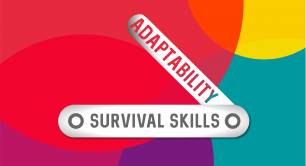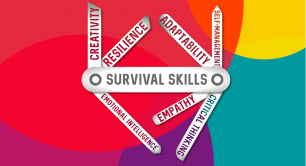Social Entrepreneurs’ Survival Skill no. 3: Creativity
Creativity leads to success – and it is a process that you can practise and develop. Explore our expert guide to creativity for social entrepreneurs – featuring six key strategies and an exercise to download. This is part three of our special series, with learning and development experts Emerald Works and Social Enterprise Academy, on the critical skills needed to flourish in a post-Covid landscape and beyond.
When it comes to ideas, we all have them – but most of us probably don’t see ourselves as creative. That’s the realm of writing Hollywood blockbusters or number one records, surely?
And that would be true of artistic creativity, the kind born of skill, technique and self-expression. But technical creativity, where you create new theories, technologies or ideas, is something that everyone can develop.
Some people are, of course, more confident or naturally gifted when it comes to creativity. But anyone can be creative – given the time, tools, support, systems and the right mental outlook.
- Interview: ‘I want to empower such women and let them see it’s not too late’ Kumbukani Zulu
- Resource: Six strategies for encouraging creativity
- Download: The Creativity Kaleidoscope
So, while creativity can involve inspiration out of the blue, it's more about a process and a habit you can practise and develop – individually and as an organisation.
Technical creativity is key to organisational and personal success. It drives innovation, efficiency, problem solving, business competitiveness and job satisfaction to name but a few.
There are two main strands to technical creativity: programmed thinking and lateral thinking.
Programmed thinking relies on logical or structured ways of creating a new product or service. Examples of this approach are Morphological Analysis and the Reframing Matrix.
Developed and popularised by Edward de Bono, lateral thinking includes approaches like Brainstorming or Random Input.
Lateral thinking recognises that our brains are pattern recognition systems. We instantly recognise patterns such as faces, language and handwriting. Without pattern recognition, we would starve or be eaten. We could not cross the road safely.
Unfortunately, we get stuck in our patterns. Solutions we develop are based on previous solutions to similar problems. Lateral thinking helps us to break out of this patterned way of thinking, to come up with brilliant, original solutions to problems.
The logical, disciplined thinking of programmed thinking is enormously effective in making products and services better. But it can only go so far before all practical improvements have been implemented.
Often the only difference between creative and ‘uncreative’ people is self-perception
A number of techniques fuse the strengths of the two different strands of creativity, such as the Concept Fan and Min Basadur's Simplex model.
Often the only difference between creative and ‘uncreative’ people is self-perception. Creative people see themselves as creative and give themselves the freedom to create. Uncreative people do not.
But being creative may just be a matter of taking a step back and asking yourself, “Is there a better way of doing something?”
And as a leader, by encouraging creative thinking, you can help your people to become more engaged in what they do, increase their self-confidence and improve their morale.
How leaders can encourage creative thinking
There are several ways to do this. First, identify and eliminate common barriers to creative thinking, such as Groupthink, where dominant parties can stifle creativity, or a fear of failure.
Next, encourage your team to think creatively. Build trust, so that your people feel safe to express their ideas, don't penalise failures or bad ideas, and lead by example.
The more time you spend fostering a sense of safety and encouragement within your team, the more creative thinking you'll start to see.
Of course, creativity also needs to be translated into something with impact in the real world. Ideas must be evaluated, improved, polished and marketed before they have any value.
The easiest way to turn ideas into reality is to create a reverse plan. When you start at the beginning, there are many directions you can take to reach your end goal, so it's easy to get lost. When you start with your end goal and work backward, things tend to come together much more easily.
By creating a plan, asking for feedback and taking action, your great idea can become a reality.
‘I want to empower such women and let them see it’s not too late’ Kumbukani Zulu
 Kumbukani Zulu is the founder of Kani K Fashions, a social enterprise in Zambia that specialises in mixed-media handmade jewellery. And, since last year, it has delivered jewellery-making classes to empower local women and young people.
Kumbukani Zulu is the founder of Kani K Fashions, a social enterprise in Zambia that specialises in mixed-media handmade jewellery. And, since last year, it has delivered jewellery-making classes to empower local women and young people.
In 2020, Kumbukani took part in the Start Your Creative Enterprise programme, which supported creatives in Zambia, Malawi and Mozambique to transform their talent into a sustainable social enterprise.
Below, she reconnects with Social Enterprise Academy Facilitator, Chembo Litana, to discuss creativity.
Chembo Litana: So Kumbukani, we met on the Start Your Creative Enterprise programme in person just before the pandemic started. What has happened to Kani K Fashions since then?
Kumbukani Zulu: Covid-19 came as a surprise. We were making short-term and long-term plans and everything was put on hold. I had just opened a new store which was only about two months old and I was trying to build that. I had to close the business and work from home.
But with a jewellery brand, which might not be a daily necessity for everyone, people needed to choose whether they wanted a piece of jewellery or a piece of chicken. I remember not being able to pay rent, deciding to shut down and moving back to the countryside and just waiting for everything to pass.
The interesting thing is that during the learning programme we were being asked, ‘What value do you offer to society?’. It was amazing that even after closing the business, people would still get in touch and say, ‘Please work on this piece, my wedding is coming up!’. As challenging as it was, I still worked, of course with limitations. It’s just now in May 2021 that I’m trying to build up. The business did go bankrupt but slowly I’m beginning to get back on my feet.
CL: As a talented and recognised jewellery designer, how have you creatively integrated the idea of having social impact into your business idea? How are you combining the two?
KZ: You might get awards, but if you don’t get awards from your neighbour then you’re not as valuable as you think. What is it that you’re doing for the people around you? What are you giving back to the community for so much that they’ve given to you?
So last year I decided to start jewellery-making classes. I thought, ‘What about the low-income people?’. The people who have the passion, but don’t have equal access to information or to the tools that they need to bring their creativity to life. So I have been working towards that – how can we generate the resources to start offering classes to low-income people, especially women and young people who are disadvantaged?
In Africa, we still have women being considered only useful at home. At Kani K Fashions, I want to empower such women and let them see it’s not too late – they still have time. While they can attend to their roles in society, they can also attend to their personal development goals in contributing to the community as human beings with equal rights.
I want to become competent enough to raise awareness of equal access to precious metals and stones. We have people in rural areas who are crafting jewellery but they can’t access the metals easily. Because there is this whole system that has been exploited by people who don’t even belong to this country. We do appreciate international investment because we know it’s an important aspect of growing the economy, but we also want to see local people benefiting from their own resources. But how do they benefit if they don’t even know that they have those resources? How do they benefit when they don’t even know how to use those resources [and transform] a raw material to the end product?
I’d like to establish an academy that offers jewellery and crafts training, especially to women and young people who wish to improve their economic status and turn their creativity into an enterprise.
CL: Wow. That is very inspiring! Of course I’d encourage you to keep pressing forwards. Is there anything else that you’ve done during Covid-19 to cultivate your creativity?
I’ve actually written my first e-book called ‘Starting with the Basics’. I’m going to publish more editions. The series will help people to perfect their skills and learn from Kani K Fashions.
Because of Covid-19 I wasn’t working much [on the business], but I have been working on myself so that I can be of help to others. If I am limited in my knowledge of jewellery, I won’t be able to offer much.
Also I decided to take my time indoors to really grow my skills on partnerships for the future, because I know that Covid-19 is not here to stay. It’s going to pass and when it passes, what is the value we’re going to get out of it? The value that I have from staying home is that I did more partnerships. I got an invitation to be a member of the Jewellery Association of Zambia which was very big for me. That opened up an opportunity for mentorship with one of the biggest jewellery companies in Zambia.
CL: One of the things we looked at on the programme was different types of leadership styles. You have mentioned previously that your natural style was more ‘pace-setting’ – what impact do you think this has had on creativity at your organisation?
KZ: Naturally I’m a very outspoken person. I always want to come into the room with that positivity – ‘Look at what we have achieved!’. While I am a pace-setter, we might have people who are visionaries, we might have people who are democratic or coaching types of leaders. How do we work together to achieve [our goals]?
If I am working with people, I make them realise that I value them as much as they value me. That I feel that the skills they have are important to help us progress.
While people will offer their skills and say, ‘This is what I have’, I will always ask, ‘Are you sure this is all you have? Can you do more? I believe in you and I know that you can do more’. Some people just don’t know what they are capable of doing.
Even before the programme, I thought that my boundaries had already reached their ends but if I just put in the effort and learn from others, I can do more. As much as I am a pace-setter, I also love to learn from others and hear what their ideas are and how we can move forward from there.”
Six strategies for encouraging creativity
1. Avoid micromanagement
Micromanagement can be a major inhibitor of creative thinking. As a leader, give your people the space and freedom to think creatively, and to work and excel independently.
2. Build trust
The relationship between you and your team should be one built on trust. Without trust and mutual respect, creative thinking cannot occur.
Creative thinking involves a certain amount of risk, and people don't take risks with those they don't trust. You can help create a sense of safety by reminding your team often how important creative thinking is to you and your organisation.
3. Don't penalise failures
Many people resist expressing their creative ideas – and especially acting on them – because they're afraid of failure. Or they might be afraid that they'll be penalised if their idea doesn't work.
As a leader, it's important to help your team overcome this fear of failure, and to recognise that good things can come from it. Many failures hide important lessons and insights that, when taken to heart, can lead to greater successes down the road.
4. Use effective brainstorming techniques
Brainstorming is a popular and effective technique for generating ideas. However, many of the barriers that inhibit creativity, such as groupthink, deference to authority and shyness, crop up during brainstorming sessions. This is why it's often more effective to use variants of brainstorming than it is to use brainstorming itself.
For instance, if you have a member of your team who tends to drown out everyone else's ideas, then use techniques like Round-Robin Brainstorming. This takes the form of everyone writing down an idea and passing it to their neighbour. The neighbour then comes up with an idea or improvement related to the original. Each card is circulated to everyone in the team. In this way, everyone’s idea is fully explored by everyone else – and everyone in the group has an equal chance to contribute.
5. Lead by example
Encourage your people to think more creatively by leading by example. Come up with your own creative ideas and don't be afraid to take risks.
And stick up for team members whenever they have an unusual idea that takes them or the team out of their comfort zones. The more you demonstrate your own creative thinking, the more your team will feel safe enough to follow suit.
6. Encourage solitude
Sometimes, people may find it easier to come up with creative ideas working alone. Whenever you can, encourage them to take time to explore new ideas. If possible, allow everyone time to pursue projects they feel passionate about.
Also, consider setting aside a specific physical space and providing the tools and resources your people need to pursue these ideas. This sense of freedom and empowerment can go a long way toward fostering a sense of creativity and excitement within your team.
|
More tools and resources to develop your creativity
|




